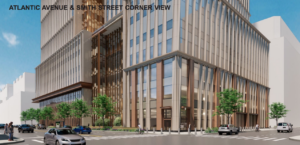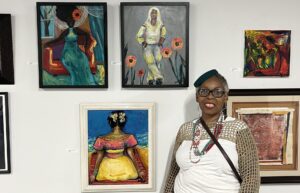The BK Borough Based Jail is Moving Forward, But Where?
Ambiguity of what a post-Rikers NYC will look like complicates new plan
By Oona Milliken | omilliken@queensledger.com
As many New Yorkers know, Rikers is set to close its doors by Aug. 2027 after former Mayor Bill de Blasio committed to shutter the jail after years of criticism of violence and poor living conditions. In its place, the plan is to construct four smaller borough-based jails in Manhattan, Brooklyn, Bronx and Queens in order to create modern facilities and more humane conditions for incarcerated individuals.
At a meeting in front of Brooklyn’s Community Board 2 on Wednesday Oct. 18, the Department of Design and Construction and HOK, the architectural firm designing the building, presented their initial plan for the Brooklyn location before their submission to the Public Design Commission for review.
The jail is set to replace the existing Brooklyn House of Detention on Atlantic Avenue in Downtown Brooklyn. However, with a growing jail population, a looming deadline to shut down the facility and Mayor Eric Adams asking for a “Plan B” to close Rikers, the future of prisoners in New York City is ambiguous.
Though Rikers is set to close in three years and ten months, it is unclear what will happen to those incarcerated at Rikers until the new borough jails are constructed. There were initially expected to be between 3,300 inmates at the four jails, according to the DDC’s website, lower than the 5,559 inmates at the Rikers facility as of 2022, as per the mayor’s annual report. Currently, all jails are expected to be expanded to a total of 4,160 beds across all four facilities according to Council Member Lincoln Restler, a number that still does not account for the discrepancy between beds and inmates.
On Wednesday, the DDC and architectural team outlined a plan that includes green landscaping, design choices that will match the architecture of the surrounding brownstones, soundproofing so that residents do not have to hear the inner goings of the jail as well as transportation for those coming in and out of the facility. Though this is their first time in front of the community board, the DDC hosted one introductory event and two design workshops with the local Brooklyn community in order to address the needs of local residents.

The Department of Design and Construction’s timeline of the Brooklyn Borough Jail facility. Photo courtesy of DDC.
The lead designer for the building, Ken Drucker, the Design Principal and the lead designer for HOK, said the firm was set to collaborate with the community in order to create a humanitarian building that is knitted into the fabric of the Brooklyn community.
“This is a normative building that creates equity and a civic building here in Brooklyn. It is important that we understand that we’re dealing with human needs, we’re dealing with community needs and we’re dealing with the fact that civic buildings create spaces that will be in existence for the next 50 to 100 years,” Drucker said in a meeting.
The main issues raised at the meeting pertained to the impact the jail would have on the surrounding area of Brooklyn Heights, Boerum Hill, Downtown Brooklyn and Cobble Hill. Many attendees brought up concerns about adequate parking so as to not clog up the surrounding streets, as well as safe transportation of prisoners to and from the jail. The parking will only accommodate 100 spots, down from 300 parking spaces, which is not enough for all the workers of the jail and does not account for police officers and visitors visiting the location. One community board attendee said that the parking would spill onto the street and congest the area surrounding the jail.
“Just from a neighborhood perspective, and I’ll be quiet after this, but you know [police officers, jail visitors and staff] will park on the street. There’s been promises and promises for the city to provide parking for their agency staff and it’s not happening so it’s become a problem in the neighborhood,” the community member said.
Ian Michaels, Executive Director of Communications and Policy for the DDC, said the DDC is committed to moving forward with the borough-based jail plan and taking steps to improve the living conditions of those incarcerated at Rikers.
“Have you ever been to Rikers? One of the things they do, when you start building jails, is they make sure you go to Rikers to see what you’re trying to improve upon, so I’ve been there a couple of times,” Michaels said. “I know what we don’t want to build because I’ve seen it myself.”
The project in Brooklyn is anticipated to be completed in 2029. In July of this year, the city expanded the number of beds in the Brooklyn jail by about 150, reducing the number of therapeutic beds intended for those with mental health issues. Michaels and Restler both said the jail in Brooklyn, expected to cost around $3 billion, is further along than the other borough-based jails.

Mock-up of what the facade of the jail will look like. Photo courtesy of DDC.
“I think the Brooklyn community has been receptive to the facility, that’s not necessarily the case at every location that we’ve been trying to build,” Michaels said. “We’re actually farther along with this facility than we are with any of the other three.”
Restler, who has been heavily involved in the fight to close Rikers, said he was frustrated by Adams’s failure to take the borough-based jails project seriously. Restler said Adams’ administration has increased arrest, summons and number of incarcerated people, both amongst minors and adults, which would not work under the new system. Adams has recently expressed skepticism about the plan and said it was flawed from the beginning.
“These are policy decisions we can control. We can invest in preventative measures, we can invest in alternatives to incarceration, we can invest in supervised release,” Restler said. “We can invest in justice-involved supportive housing, or we can fill up our jails. Mayor Adams is choosing to do the latter.”
In the CB2 meeting, Kiumars Q. Amiri, the Executive Director of Capital Projects at the Mayor’s Office, in contrast with Restler’s comments, said the city was attempting to reduce the overall prison populace in order to address this discrepancy.
“The goal is to reduce the overall population with more smart policies that would sort of disrupt recidivism patterns, provide more stable programs for folks not to be caught in the system, alternatives to incarceration, electronic monitoring to constitute supervised released programs. There’s a whole host of programs that go hand in hand with this, this building, this borough-based jail program is one bubble of the bigger system,” Amiri said.
Restler said it was imperative to move forward with the borough-based plan despite any challenges. The council member acknowledged that the Brooklyn jail had some hurdles in order to be constructed, including figuring out a lack of parking and the removal of therapeutic beds, but said that Rikers was an unacceptable space for New York’s incarcerated population.
“[Rikers] is a despicable hell hole. It is an embarrassment for every resident of New York that we’ve sent people there to rot on a daily basis. We have, over the last 30 years, during the Giuliani, Bloomberg and De Blasio administrations safely reduced the number of people who are incarcerated in New York City while achieving record-low crime rates. We can continue to drive down crime, improve public safety and reduce incarceration if we have the political will to do it,” Restler said.
After the plan is submitted to the initial Public Design Commission for conceptual review, the plan will undergo further evaluation as well as a preliminary PDC review before it is resubmitted for final review to the PDC in the spring of 2023. The last step before launching construction of the jail will be a community presentation, also in the spring of 2024.








